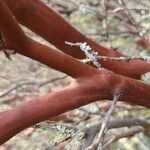Shrubs or trees, erect, 2-5 m; burl absent; twigs densely short-hairy, usually with long, white hairs, often glandular. Leaves: petiole 4-10 mm; blade dark green, dull, lanceolate-ovate to narrowly oblong-ovate, 4-6 × 2-3 cm, base cuneate to ± rounded, margins entire, plane, surfaces ± papillate, finely scabrous, finely hairy, sparsely glandular-hairy. Inflorescences panicles, 3-8-branched; immature inflorescence pendent, branches ± spreading, axis 1.5-2.5 cm, 1+ mm diam., densely short-hairy, usually with long, white hairs, sometimes glandular; bracts not appressed, (green), leaflike, oblong-lanceolate, 10-18 mm, apex acuminate, surfaces finely glandular-hairy. Pedicels 2-4 mm, finely glandular-hairy. Flowers: corolla white, conic to urceolate; ovary densely white-hairy, sometimes sparsely glandular. Fruits depressed-globose, 8-11 mm diam., sparsely hairy. Stones distinct. 2n = 26.
More
A small tree. It grows 6 m high and spreads 3.5 m wide. The bark is peeling and purplish-brown. The twigs are white and have bristles. The leaves are oval and 5 cm long. The flowers are white to pink and in nodding clusters. The fruit are small, bright red berries.
Chaparral, gaps and margins of conifer forests along the coast, sometimes extending inland, open areas around rock outcrops; at elevations from sea level to around 1,000 metres, occasionally to 1,400 metres.
More
It is a temperate plant. It is best in well-drained soil. It needs an open sunny position. It is resistant to drought and frost. It suits hardiness zones 7-9.




